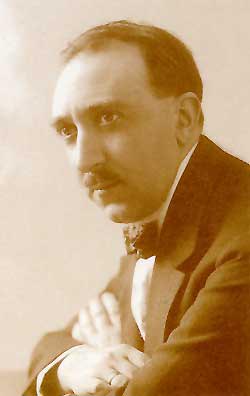|

Jesús Guridi
(1886 -
1961)
|
 The Basque
Jesús Guridi has a national significance beyond his fame as the
composer of El caserío. Indeed,
his Diez melodías vascas ("Ten Basque Songs") is something like
the Basquais equivalent of Elgar's Enigma Variations. Born in
Vitoria, September 25th 1886, Guridi's talent was recognised early. His musical
family sent him to study at the Conservatory in Madrid, and at sixteen he
received a bursary from the Count of Zubiria which enabled him to spend
two years at the Schola Cantorum in Paris - where he worked under
Vincent d'Indy, whose influence is apparent in much of his music. He
later went to Joseph Jongen in Brussels, and studied instrumentation
with Otto Neitzel in Cologne (1908) before returning home to teach organ
at the Bilbao Academy of Music. He also took on the direction of the
Sociedad coral, and taught organ and composition at the newly founded
Biscay Conservatory. The Basque
Jesús Guridi has a national significance beyond his fame as the
composer of El caserío. Indeed,
his Diez melodías vascas ("Ten Basque Songs") is something like
the Basquais equivalent of Elgar's Enigma Variations. Born in
Vitoria, September 25th 1886, Guridi's talent was recognised early. His musical
family sent him to study at the Conservatory in Madrid, and at sixteen he
received a bursary from the Count of Zubiria which enabled him to spend
two years at the Schola Cantorum in Paris - where he worked under
Vincent d'Indy, whose influence is apparent in much of his music. He
later went to Joseph Jongen in Brussels, and studied instrumentation
with Otto Neitzel in Cologne (1908) before returning home to teach organ
at the Bilbao Academy of Music. He also took on the direction of the
Sociedad coral, and taught organ and composition at the newly founded
Biscay Conservatory.
In 1914 he began teaching organ in Madrid, finally moving there to
live in 1939, as Professor of Theory at the Conservatory and director of the
Ufisa Film Corporation. Various honours came his way, and in 1956 he was
finally appointed Director of the Conservatory. Though he died on 7th April,
1961 in Madrid, he never lost touch with his regional roots and by the time of
his death had become virtually the Basque National Composer. His son
Ignacio wrote: "My father was an upright Basque, filled with the spirit
and vitality of his people ... capturing the sounds of a flowing river, the
majesty of a mountain, the rustling of trees, or of a wandering txistu
flute."
 Guridi's place
in Spanish music goes way beyond his influence as an academic. Aside from
quantities of film music, his orchestral compositions range from the
d'Indyesque symphonic poem Una aventura de Don Quijote (1915), through
the famous Diez melodías vascas (1941) to the remarkable
Homenaje a Walt Disney for piano and orchestra (1956) and - possibly his
orchestral chef d'oeuvre - the Sinfonía pirenaica (1945).
His organ works, notably the Triptico del Buen Pastor, have been played
and recorded throughout Europe. His many songs, piano and chamber works such as
the two String Quartets have not. His choral works - pre-eminently the
thrilling Euzko Irudiak ("Basque Scenes") of 1922 - are highly
effective, though lack of familiarity with the Basque language abroad has
mitigated against their wider exposure. Guridi's place
in Spanish music goes way beyond his influence as an academic. Aside from
quantities of film music, his orchestral compositions range from the
d'Indyesque symphonic poem Una aventura de Don Quijote (1915), through
the famous Diez melodías vascas (1941) to the remarkable
Homenaje a Walt Disney for piano and orchestra (1956) and - possibly his
orchestral chef d'oeuvre - the Sinfonía pirenaica (1945).
His organ works, notably the Triptico del Buen Pastor, have been played
and recorded throughout Europe. His many songs, piano and chamber works such as
the two String Quartets have not. His choral works - pre-eminently the
thrilling Euzko Irudiak ("Basque Scenes") of 1922 - are highly
effective, though lack of familiarity with the Basque language abroad has
mitigated against their wider exposure.
His Basque-language stage works include the "symphonic idyll"
Mirentxu (1910) and three-act opera Amaya (1920), as well as a
sequence of popular Spanish language zarzuelas concerned with Basque country
and maritime life. El caserío
(1926), to a finely crafted libretto by Romero
and Fernández Shaw, is an acknowledged classic - though La
Meiga (1928), La Cautiva (1931) and Mari-Eli (1936) are not
far behind it in quality.
 Guridi's
language is rooted in the musical forms and rhythms of his homeland. French
rather than Spanish composers provided his stylistic models, though its
distinctive nationalist flavour makes his music sound closer to central than
southern Europe. His style - despite weird echoes of Messiaen's
Turangalila in the late Walt Disney Homenaje - is generally
conservative, and his brilliance as an orchestrator in works like the Diez
melodías makes it tempting to think of him as the Spanish
Respighi. On closer acquaintance, though, his music reveals a quiet
depth of feeling all its own, as anyone who has come to know El caserío will appreciate well
enough. Guridi's
language is rooted in the musical forms and rhythms of his homeland. French
rather than Spanish composers provided his stylistic models, though its
distinctive nationalist flavour makes his music sound closer to central than
southern Europe. His style - despite weird echoes of Messiaen's
Turangalila in the late Walt Disney Homenaje - is generally
conservative, and his brilliance as an orchestrator in works like the Diez
melodías makes it tempting to think of him as the Spanish
Respighi. On closer acquaintance, though, his music reveals a quiet
depth of feeling all its own, as anyone who has come to know El caserío will appreciate well
enough.
[Back to top of
page] |

